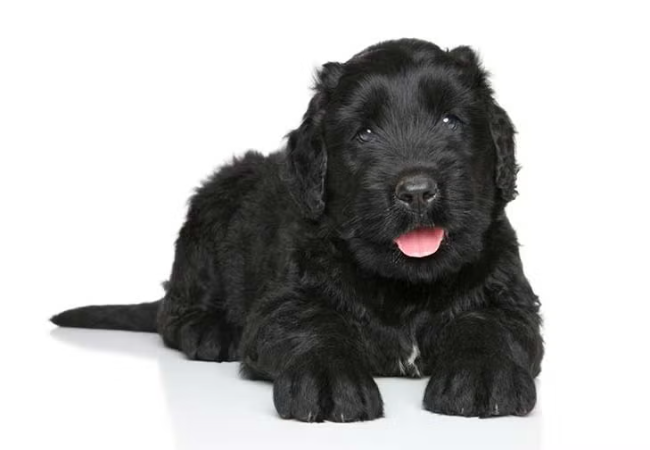Black Russian Terrier 2025 Guide: Temperament, Care & Training 🐾

In this article
Black Russian Terrier 2025 Guide: Temperament, Care & Training 🐾
By Dr. Duncan Houston BVSc
🐶 Breed Overview
The Black Russian Terrier (BRT), known also as the Russian Black or Chornyi Terrier, is a large, intelligent, working breed developed in the USSR between the late 1940s and early 1950s at Red Star Kennels. Its foundation stock included breeds such as Giant Schnauzer, Airedale Terrier, Rottweiler, Newfoundland, and Caucasian Shepherd, creating a sturdy, versatile guardian breed.
Standing 26–30 in and weighing 80–130 lb, BRTs are powerful and athletic, yet surprisingly agile given their size.
Temperament & Suitability
- Confident & Calm: BRTs are composed, courageous, and self-assured—ideal for those seeking a poised guardian.
- Family-Oriented: They are loyal and affectionate with their families and can be gentle with older children.
- Reserved with Strangers: Naturally wary and protective, they require early socialization to manage suspicion.
- Not for Novices: Their guarding instincts, independence, and size make them challenging for first-time dog owners.
Exercise & Mental Stimulation
BRTs are working dogs—they thrive when given both physical and mental outlets. They require at least 60–120 minutes of daily exercise, combining walks, hikes, swim sessions, or games like fetch and puzzle-solving.
Agility, obedience, and advanced training not only channel their intelligence, but provide a sense of purpose that reduces destructive behavior.
Training & Socialization
Start training and socialization early—puppyhood is critical. Use firm, consistent, positive reinforcement to establish leadership. This helps manage their protective instincts and ensures confidence around strangers and other pets.
Without a job, BRTs may become bored and destructive. Structured challenges like obedience, trick training, or Schutzhund-style protection work suit them best.
Grooming & Care
BRTs possess a dense, coarse double coat with a soft undercoat—low shedding but prone to matting.
- Brushing: 2–3 times weekly (daily in problem areas like legs and beard) with slicker brushes and undercoat rakes.
- Trimming: Every 6–8 weeks, including beard, eyebrows, and paw edges—professional grooming is helpful.
- Bathing: Monthly or as needed to maintain cleanliness.
- Routine Care: Weekly ear checks, monthly nail trims, and several-times-weekly teeth brushing.
Health & Lifespan
BRTs are robust, with a lifespan averaging 10–12 years (a UK study reported 10.9 years).
Common health issues include:
- Hip & elbow dysplasia—ensure screening before breeding.
- Progressive retinal atrophy (PRA)—leading to vision loss.
- Hyperuricosuria / urinary stones—manage with diet, meds, or surgery.
- Juvenile laryngeal paralysis & polyneuropathy (JLPP)—nerve disorder causing breathing issues.
- Other potential conditions: cardiomyopathies, eye problems (entropion, ectropion), allergies, developmental bone diseases.
💡 Vet Tip: Use breed-specific pet insurance and ensure pre-purchase health screening for hip, elbow, eyes, and JLPP.
Nutrition
Feed high-quality, large-breed formulas with joint-support nutrients. Puppies up to 18 months old need 3–4 meals daily; adults typically enjoy 2 meals/day to reduce bloat risk.
Average daily intake: 3–4½ cups, depending on age, weight, and activity.
Recommendations:
- Prevent bloat: avoid rigorous exercise near mealtimes and consider slow-feeder bowls.
- Include omega-3s for coat health, glucosamine/chondroitin for joints, and probiotics for digestion.
- Monitor weight and body condition; adjust calories as needed.
- Consult a vet or Ask A Vet for personalized nutrition strategies.
Breed-Specific Insights
- Exercise tolerance: Capable of 3–4 mile runs; avoid heat stress due to thick coat.
- Guard instincts: Excellent watchdogs; good training can prevent over-guarding.
- Suitable homes: Require indoor family life and secure yards; unsuitable for apartment living — they suffer if left alone.
- Compatibility: Well with older children, supervised with smaller pets due to hunting instinct.
Choosing Your BRT
As a rare breed, locating a quality puppy may take effort. Expect to pay $2,000–$4,000. Always choose a reputable breeder who provides health clearances (hips, elbows, eyes, JLPP), and consider adoption via breed rescue.
🏡 Is a Black Russian Terrier Right for You?
Ideal for experienced owners seeking a loyal, trainable, protective companion with the time and dedication for training, grooming, and veterinary care. Not suited for novices, small-space living, or families lacking commitment. If that sounds like home, a BRT can be an exceptional family guardian.
References & Further Reading
- PetMD — comprehensive breed profile.
- American Kennel Club breed standard.
- Orvis, DailyPaws, Healthy Paws, Wikipedia — supplemental breed history and health data.
Ask A Vet tip: Veterinarian‑led support is available for tailoring your BRT’s nutrition, behavior, or health plans—reach out anytime!






